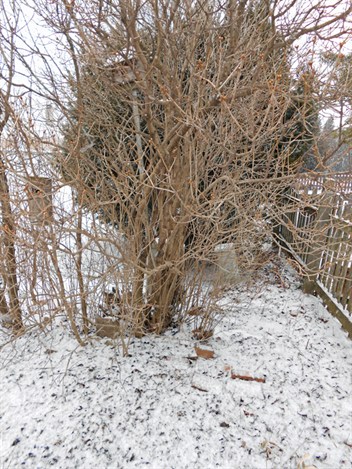Examples:
Common lilac (Syringa vulgaris and
"French hybrid lilacs)
Honeysuckle (Lonicera
species)
Dwarf lilac (Syringa pubescens
patula)
Common lilac
It hadn't been pruned in a long time and had become a thicket,
with some canes producing very little flower and dying back in
midsummer. We removed some old canes to let light reach the
vigorous younger suckers, and thinned those, too.


Pruning a lilac is important for its health: Keep a lilac pruned
so its main canes don't get thick enough to host lilac borer. (More
and very useful info about that borer in What's Coming Up
Ensemble Editions #
63 and #
114.)
When a lilac's grown unchecked for some years, it can be a real
chore to cut out some of the old wood-- tough to work the saw
between trunks crammed one next to another. So after you sort out
an older lilac like this (below, left, before the cuts; below,
right after), begin pruning it annually, a little bit each
year rather than taking on this challenge again. Remove one old
trunk each spring, sawing it out at ground level. Remove weak
suckers. Thin the remaining suckers.


Eventually, the thick trunks we left will need to come out, too.
We removed the most gnarly that had the most evidence of
borers.


Honeysuckle
Here's before and after of a shrub that had become so crowded at
its base and interior that it was producing foliage only at its
extremities. It was unattractive, and harder to shear every year as
the branches become thicker. On a cold day in late March we removed
some old canes to allow new growth from the base and in the
center.


Could we have cut it all the way to the ground and started over?
Yes. However, that would have eliminated this year's bloom and
probably have resulted in a forest of suckers that would urgently
need thinning. Leaving some of the old wood means there will be
some bloom this year and suckering won't be so wild.
Next year -- or later this summer --- we'll remove the remaining
old stems. Afterwards we'll put the shrub on an annual pruning
schedule, to remove about 1/4 of all the trunks each spring. On
that regimen, every cane will grow straight up (like the
unbranched central canes above, right) to about four feet tall
in year one, branch and bloom in its second and third years, and
then be cut out in year four to make way for newer growth.

Dwarf lilac
Below: The dwarf lilac before pruning, then with the dead
removed, then with the remainder thinned and shortened.



(There's another problem here, beyond
overgrowth that needed pruning...)